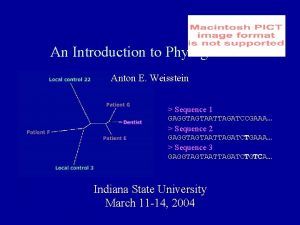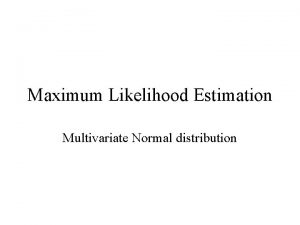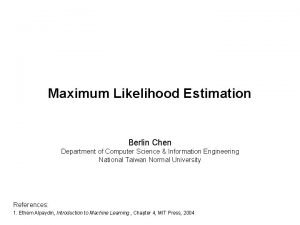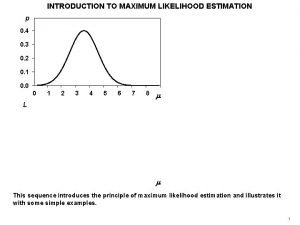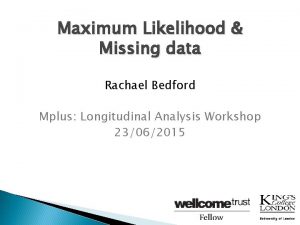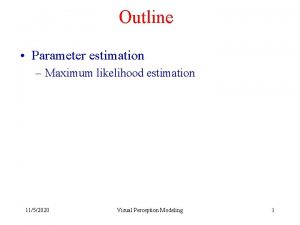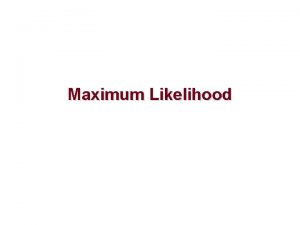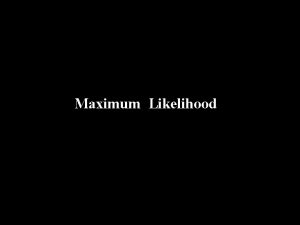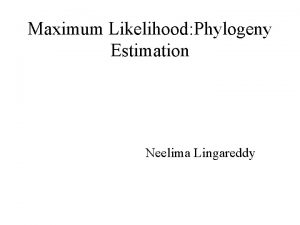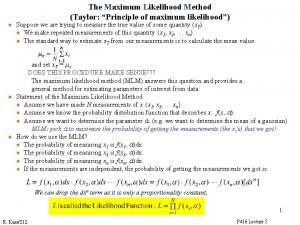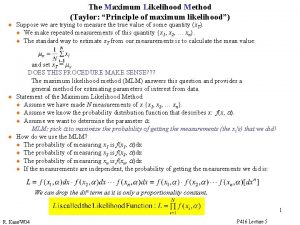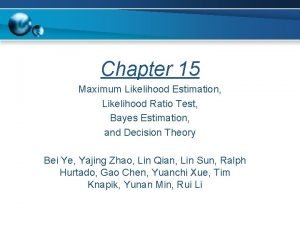Lecture 5 The Maximum Likelihood Method l Suppose








- Slides: 8

Lecture 5 The Maximum Likelihood Method l Suppose we are trying to measure the true value of some quantity (x. T). u We make repeated measurements of this quantity {x 1, x 2, … xn}. u The standard way to estimate x. T from our measurements is to calculate the mean value: and set x. T = mx. DOES THIS PROCEDURE MAKE SENSE? ? ? The maximum likelihood method (MLM) answers this question and provides a general method for estimating parameters of interest from data. l Statement of the Maximum Likelihood Method u Assume we have made N measurements of x {x 1, x 2, … xn}. u Assume we know the probability distribution function that describes x: f(x, a). u Assume we want to determine the parameter a. MLM: pick a to maximize the probability of getting the measurements (the xi's) that we did! l How do we use the MLM? u The probability of measuring x 1 is f(x 1, a) u The probability of measuring x 2 is f(x 2, a) u The probability of measuring xn is f(xn, a) u If the measurements are independent, the probability of getting the measurements we did is: u L is called the Likelihood Function: R. Kass/F 02 P 416 Lecture 5

u u We want to pick the a that maximizes L: Often easier to maximize ln. L. L and ln. L are both maximum at the same location. Also, maximize ln. L rather than L itself because ln. L converts the product into a summation. The new maximization condition is: n n l a could be an array of parameters (e. g. slope and intercept) or just a single variable. equations to determine a range from simple linear equations to coupled non-linear equations. Example: u Let f(x, a) be given by a Gaussian distribution function. u Let a = m be the mean of the Gaussian. We want to use our data+MLM to find the mean, m. u We want the best estimate of a from our set of n measurements {x 1, x 2, … xn}. u Let’s assume that s is the same for each measurement. gaussian pdf u The likelihood function for this problem is: R. Kass/F 02 P 416 Lecture 5

u Find the a that maximizes the log likelihood function: factor out s since it is a constant don’t forget the factor of n Average u If s are different for each data point then a is just the weighted average: Weighted Average R. Kass/F 02 P 416 Lecture 5

l Example u Let f(x, a) be given by a Poisson distribution. u Let a = m be the mean of the Poisson. u We want the best estimate of a from our set of n measurements {x 1, x 2, … xn}. u The likelihood function for this problem is: u Find a that maximizes the log likelihood function: Average Some general properties of the Maximum Likelihood Method J For large data samples (large n) the likelihood function, L, approaches a Gaussian distribution. J Maximum likelihood estimates are usually consistent. For large n the estimates converge to the true value of the parameters we wish to determine. J Maximum likelihood estimates are usually unbiased. For all sample sizes the parameter of interest is calculated correctly. J Maximum likelihood estimate is efficient: the estimate has the smallest variance. J Maximum likelihood estimate is sufficient: it uses all the information in the observations (the xi’s). J The solution from MLM is unique. L Bad news: we must know the correct probability distribution for the problem at hand! R. Kass/F 02 P 416 Lecture 5

Maximum Likelihood Fit of Data to a Function l Suppose we have a set of n measurements: u u u Assume each measurement error (s) is a standard deviation in the Gaussian sense. Assume that for each measured value y, there’s an x which is known exactly. Suppose we know the functional relationship between the y’s and the x’s: n l a, b. . . are parameters. MLM gives us a method to determine a, b. . . from our data. Example: Fitting data points to a straight line: u Find a and b by maximizing the likelihood function L likelihood function: two linear equations with two unkowns R. Kass/F 02 P 416 Lecture 5

For the sake of simplicity assume that all s’s are the same (s 1= s 2= s): We now have two equations that are linear in the unknowns a, b: in matrix form These equations correspond to Taylor’s Eq. 8. 10 -8. 12 R. Kass/F 02 P 416 Lecture 5

l u u EXAMPLE: A trolley moves along a track at constant speed. Suppose the following measurements of the time vs. distance were made. From the data find the best value for the speed (v) of the trolley. Time t (seconds) 1. 0 2. 0 3. 0 4. 0 5. 0 6. 0 Distance d (mm) 11 19 40 49 61 33 Our model of the motion of the trolley tells us that: u u We want to find v, the slope (b) of the straight line describing the motion of the trolley. We need to evaluate the sums listed in the above formula: best estimate of the speed d 0 = 0. 8 mm R. Kass/F 02 best estimate of the starting point P 416 Lecture 5

The MLM fit to the data for d=d 0+vt u. The line best represents our data. u. Not all the data points are "on" the line. u The line minimizes the sum of squares of the deviations between the line and our data points. n See the least squares fitting lecture for more discussion. R. Kass/F 02 P 416 Lecture 5

